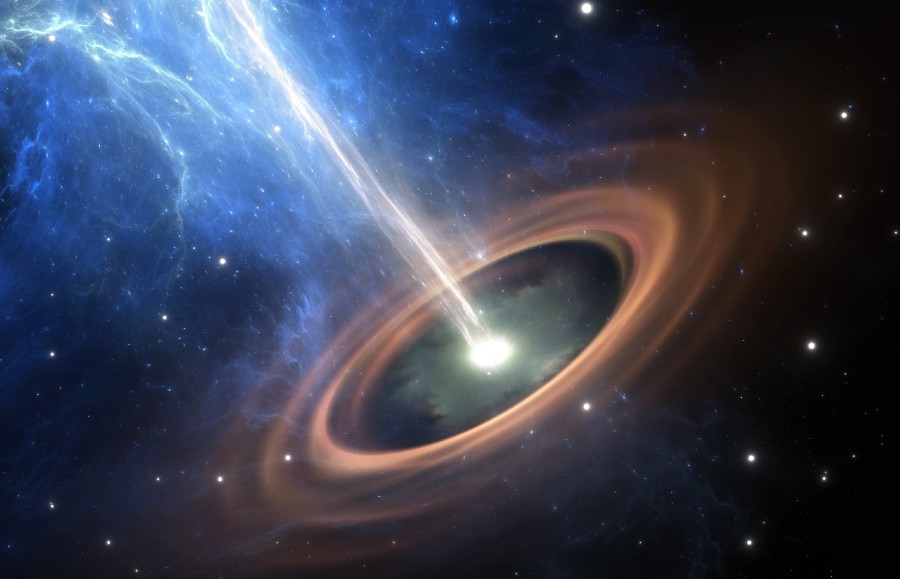Albert Einstein was taken aback when German physicist Karl Schwarzschild solved Einstein’s equation within two months of its publication in 1915.
The general gravitational equation, which describes the space-time around any matter distribution, is so complex that Einstein believed it could never be solved. Today, the Schwarzschild black hole solution, as it is known, is understood to be the most important solution of the Einstein equation. Scientists were awed when the full implication of the solution was revealed in the 1960s. It turns out that when an object is compressed sufficiently, its gravity becomes so strong that even light cannot escape its grip. There is no way for an outside observer to see what is happening inside the boundary — known as the event horizon — around a black hole since even light is pulled inside.
The compressed object, otherwise known as a black hole, will continue to shrink to oblivion — cutting out a chunk of space-time from this universe — and meet its inevitable future called singularity where its identity vanishes altogether. For all practical purposes, the object would leave this observable universe as it goes behind the veil of the event horizon.
Scientists did not much like the notion of black holes right from the beginning. One untidy aspect of the Scwarzschild solution is it deduces that the dynamic behaviour of any matter around a black hole is not dependent on the properties of the matter that form the black hole, except its mass. In other words, if an elephant and a pick-up truck of the same mass are compressed to form two mini black holes, observers will not notice any difference between the two. Similarly, a black hole’s mass will increase by the same amount, whether it swallows a cell phone stuffed with information or a sandwich of the same mass. This concept is difficult to accept and common sense is often baffled when such “physical” objects are found in our astronomical backyard.
If that was not bad enough, along came Stephen Hawking. In the early 1970s, he found that if he applied quantum field theory just outside the “event horizon”, the vacuum outside the horizon should split into matter and anti-matter like any other vacuum, but one part would go into the black hole while the other would go a large distance away as a free particle. So a distant observer would think that the black hole is radiating! This so-called Hawking radiation is a slap on the face of a rational thinker. Because it says that eventually the entire mass of the black hole would become zero by evaporating through Hawking radiation. Not only the mass but also all the information that went into black hole would be gone forever.
Hawking realised that these two branches of physics — namely quantum mechanics and gravity — are applicable in completely different scales. Quantum processes are important on the microscopic scale while the general relativity theory describing the gravitational field of distributed matter deals with only gross properties. He was curious only to understand the microscopic processes in a classical black hole event horizon. However, Hawking’s findings violated the basic tenet of quantum field theory whose basic principle is that not only can we exactly predict the future from the present observable universe with the help of all the information around, but we should also be able to calculate backward in time to see what the universe was like in the distant past. But if a black hole guzzles all types of matter and spits out radiations devoid of information forever, it would be impossible to predict the future from the knowledge of the present or the past with the help of partial information left in the observable universe.
This gave rise to the “information paradox”. If there are classical black holes around, or, if the entire universe is formed again from regurgitation of a gigantic black hole containing all the matter of the universe, eventually the universe will have its mass and energy back, thanks to the Hawking evaporation of black holes, but there will be no information left. This is simply preposterous. The obvious problem must lie in the fact that Hawking did not quite combine gravity and quantum theory at the basic level. He simply applied quantum theory on the top of a classical object. It was a patch-up job.
What if the matter sneaking into a black hole leaves its information on the horizon and simply collects it back during evaporation? But that cannot be. Information is not a baggage that you can leave out at your will. You could duplicate yourself and leave a copy on the horizon as soft silky “hair” which can be pulled at will for some information.
Now, the story gets a further twist. As mentioned earlier, the vacuum around a black hole is split in two particles that remain connected to each other — by the so-called quantum entanglement — because they need to be together to form the vacuum back. So, the “free” particle of the Hawking radiation outside the horizon is not really free and is entangled with its partner inside the horizon. This partner, though, cannot meet its inevitable future, that is, the singularity, unless the entanglement is removed.
It is only now that physicists feel they have finally found a solution to this paradox. The idea is to let the partner inside reappear through a wormhole into another connected world which will remove the entanglement. This leads to other possibilities: did our universe actually reappear this way? Was the Big Bang nothing but the emergence of radiation from another universe? Were many baby universes formed this way, and we are simply sitting in one of them? Alternatively, are we sitting inside a gigantic back hole accelerating to reappear in another one? This possibility may resolve another interesting observation that the universe is expanding with an acceleration and not with a constant velocity as Edwin Hubble first found a century ago.
Our understanding of the universe is getting better and better.
The writer is the director of the Indian Centre for Space Physics, Calcutta










